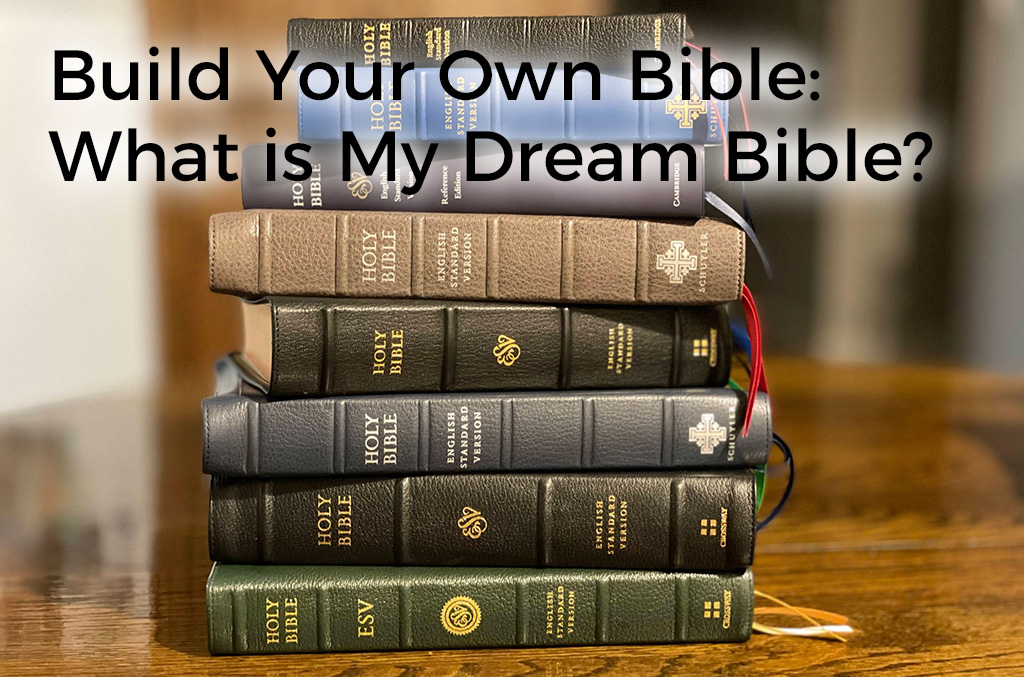
BYOB: Build Your Own Bible!
Here’s a cool little exercise: if you could put together your “dream Bible”, what would it look like?
Think hard and see what you would consider to be the “ultimate,” all-purpose, everyday Bible for you. Do you have a preferred translation, features, or look and feel for what best suits you? If you had absolute total control over all of the different publishing houses like Zondervan, Crossway, Thomas Nelson, and others, and get them to collaborate to release your own dream edition, what would it include?
Before we get to the fun, keep in mind that there is no substitute for a good, plain Bible. Any solid, accurate English rendering of the original Hebrew and Greek texts done by a reputable translation committee is really all you need. Just as long as you sit daily with the 66 books of Scripture and let the Word of God transform you, all the other features are just “icing on the cake.”
So if I could “BMOB” or “Build My Own Bible,” what would it be?
Translation:
ESV. Runners-up: NIV and LSB. While I use all of these translations (and more) in my studies, I think that the ESV is a straightforward, highly-accurate translation that still is fairly easy to read.
My main, “every day” Bible has been the NIV for a number of years now, but there are times I wish the wording was a little closer to the original Hebrew and Greek text. I love the newer LSB (Legacy Standard Bible), as well as the NASB95 on which it is based, but the literalness of the strict rendering can be a bit limiting to our everyday reading. Another honorable mention is the CSB for its astute balance between formal and dynamic equivalency.
It would be nice to have an ESV/NIV or ESV/LSB parallel, but those can be viewed electronically online; and in my opinion, would take up too much room on paper for my dream Bible.
Translation Notes/Cross Reference/Chain Reference:
Yes. The deeper I get into studying, the more I use these often-unappreciated resources.
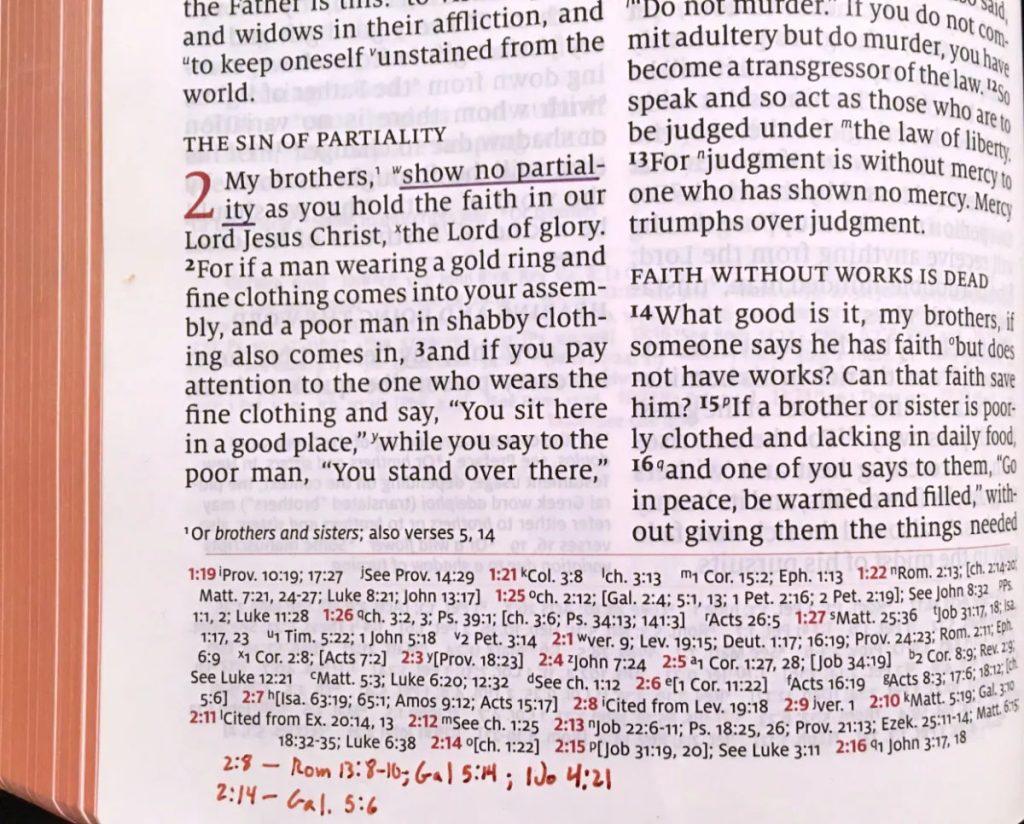
Built-In Study Bible Commentary:
No. Whew! This option was a tough one to decide. I’ve gotten tons of mileage out of my NIV and ESV Study Bibles, as well as various other commentaries written by Bible scholars. There’s hardly a day that goes by that I don’t refer to some type of wisdom or guidance from men in written form to help explain the text.
But of course, humans are fallible, and commentaries can be a theological crutch if you rely on them too much. At times it’s better to scour the larger passage and chapter, as well as being able to look up the aforementioned cross-references in other Bible books, to form a better exegesis of difficult-to-comprehend verses.
Lastly, do I love extended commentary notes on the translation of which I’m reading. So maybe a smaller amount of commentary notes on “here’s what the passage means” and more of “here’s what the original language of the passage reads.”
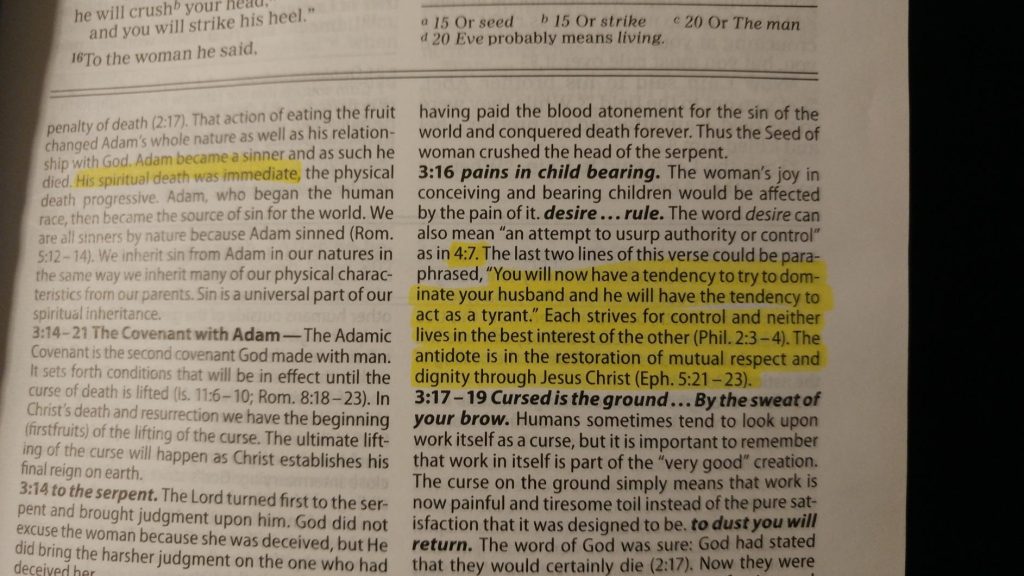
Concordance:
Yes. It needn’t be exhaustive, but thorough enough on the main subjects.
Glossary:
Yes.
Introductions/Translation Notes/Summaries:
Oh, absolutely. I can’t get enough of this kind of stuff!
Maps/Charts/Graphs/Extra Features:
For the most part, a resounding “yes,” especially regarding maps and charts. I love them! I’m a severe nerd when it comes to that kind of stuff. I often find historical context articles and little featurettes you would find in study Bibles mostly helpful. Diagrams such as ancient Jerusalem city layouts or the rendering of the two Jerusalem Temples are fantastic!
On the other hand, photographs of items from archeological digs or ancient structures are hit and miss. Typically, I don’t need them. But it does depend on the context.
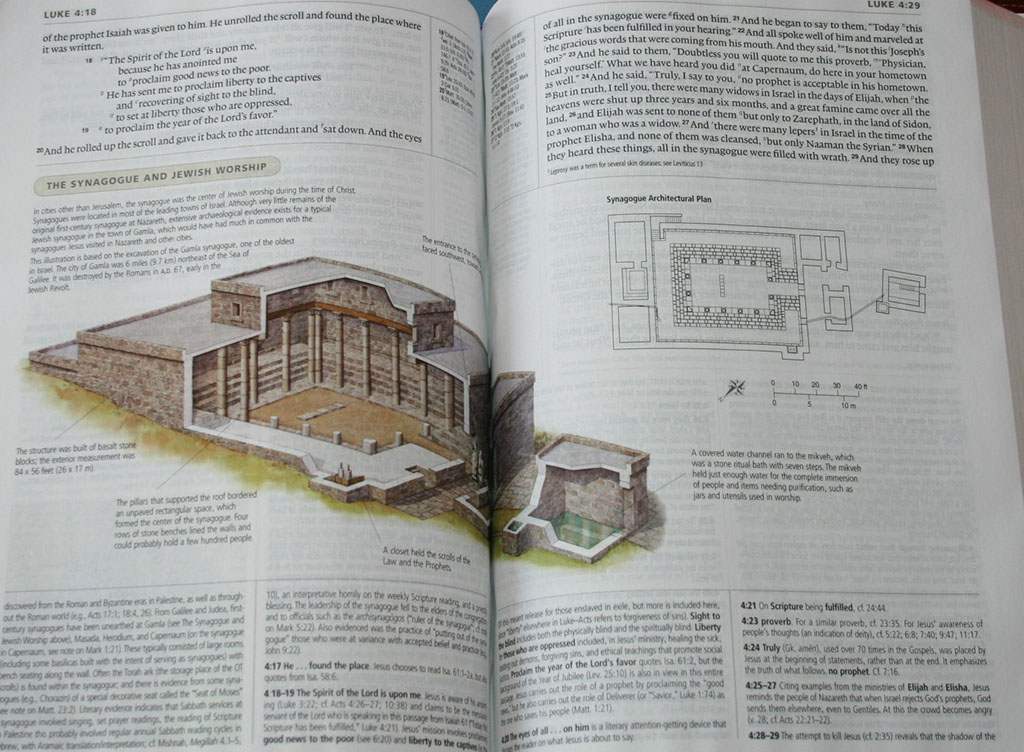
“Themed” Bibles:
No. I do not want this to be a large study Bible with a particular theme. While I appreciate special Bibles for a specific audience or niche interest (Bibles for women or men, apologetics Bibles, First-Century culture Bibles, Q&A Study Bibles, devotional Bibles, etc.), that’s not what I desire in my fantasy Bible.
Study Bible Articles:
No. It really depends on what they’re about. I’m not a fan of pieces that give a heavy theological slant on things, even if they are mostly correct, such as the NLT Life Application Study Bible does. Please don’t give me a theologian’s or pastor’s opinion in a piece he’s written in the sidebar; let me read the actual Word of God and uncover that for myself.
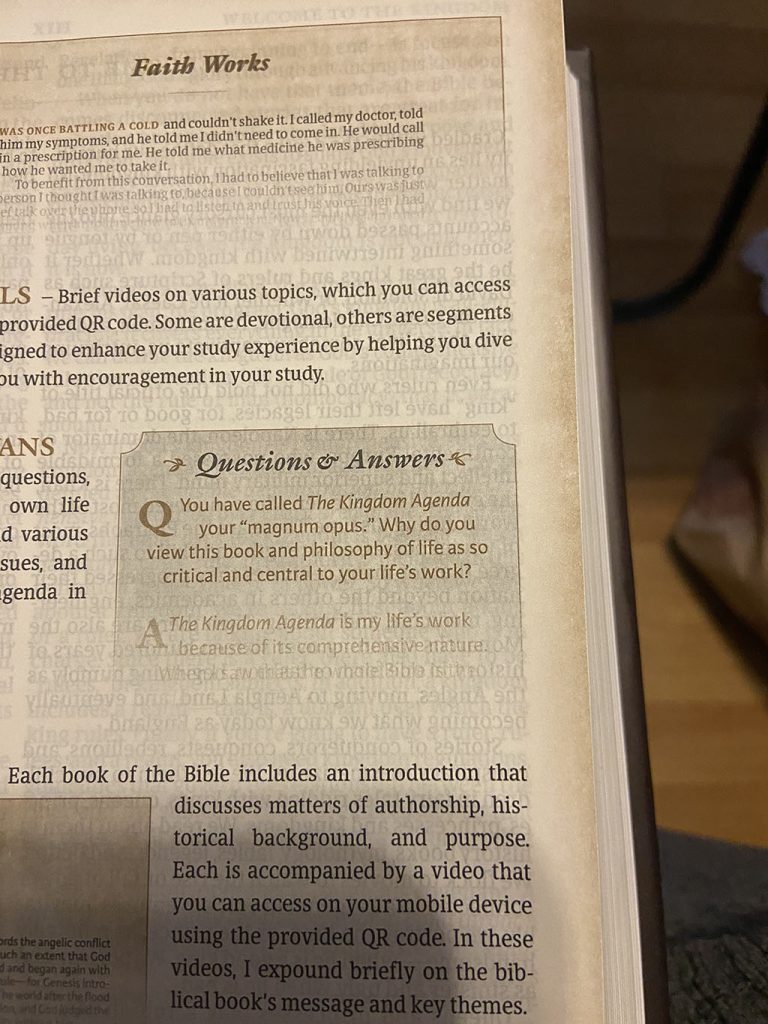
Margins:
I’m not super-picky. I’m not a huge note-taker in my Bibles, so as long as it’s large enough so that I can write a few brief points I’m happy.
Subject Headings:
Yes. Sure, leave them in. For those of you who may not know what I’m referring to, these are the brief sentences written by translators to describe a big chunk of passage that follows it, such as “Jesus Enters Jerusalem,” and are not part of the original Hebrew or Greek manuscripts of the Bible.
Words of Christ in Red?
Yes. It’s not a deal-breaker not to have them, but I “grew up” loving red letter Bibles, and I still get a benefit from reading the Gospels and seeing Jesus’ words in red. Ultimately, all of the Bible is the Holy Spirit-inspired Word of God, from Gen. 1:1 to Rev. 22:21.
Tetragrammaton (The Name of God) in the Old Testament:
LORD, instead of YHWH or Yahweh. Just a personal preference.
Divine Pronouns:
Capitalized. For clarity, and for respect of the Members of the Godhead.
Print Size:
It needs to be on the larger end, say 10- to 12-point font. I’m at the point where I need reading glasses for small text or reading in low-light situations, so this is a must.
Typeface:
I’m not picky, but I prefer it to be a clean, readable serifed font with well-spaced kerning in between the letters.
Ribbons:
Yes, I would LOVE at least four or five (yes, that many) ribbons to bookmark pages. This is sadly lacking in most Bibles, where you’re lucky if you get one or two. I’m in multiple books of the Bible simultaneously for many different reasons, so ribbons do aid in keeping track of things.
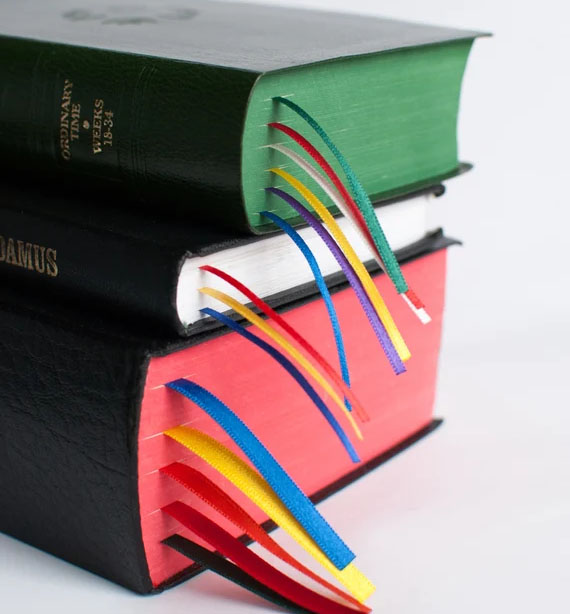
Binding:
The Bible must lay flat when opened, even if it’s Genesis chapter 1 or Revelation chapter 22.
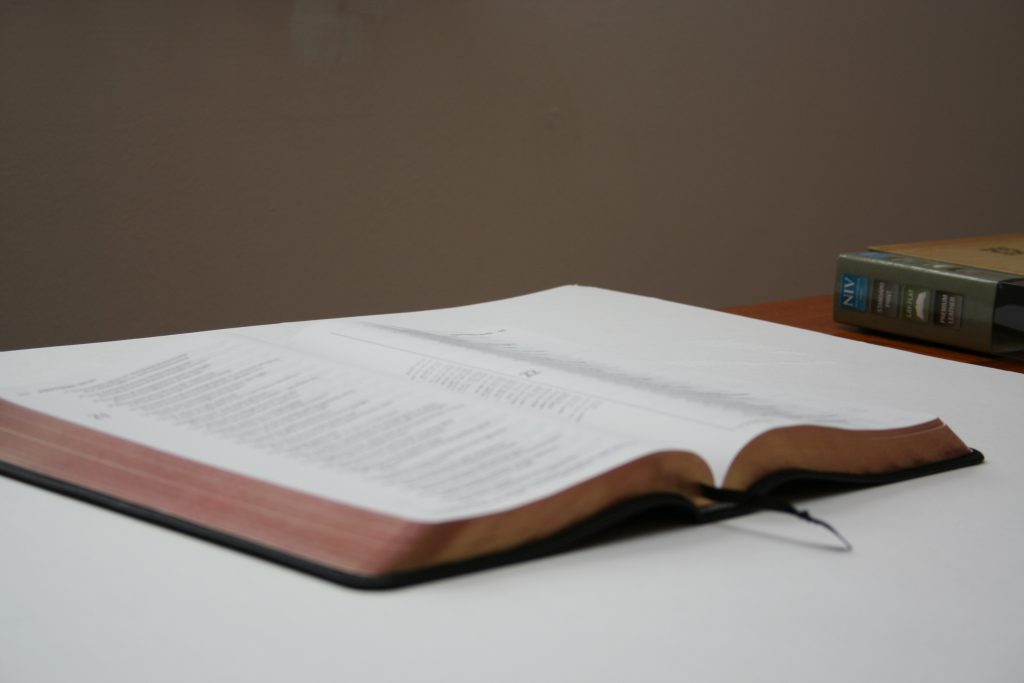
Cover:
Soft, comfortable, durable, and still pliable cowhide leather. Preferred color? I’d instead go with a lush, rich brown or a brown/grey combo than a “funeral black” look.
Thumb Index Indentations:
No. I’ve never cared for ’em.
Gilding (metallic edges to the paper):
Yes. Silver.
Colors and Print on Paper:
While I love intuitive graphic design and sharp layout, I’d like the paper to be all white and the text to be all black (except for the words of Christ in red). No blue margins or weird gradients of tan or brown on the tops or bottoms of the pages.
There are numerous exceptions for adding color in particular spots, such as full-color maps, isolated article boxes or sidebars, or colors in charts.
Paper thickness:
Nothing too thin. I would rather the Bible be thicker and heavier than have my highlighter pens bleeding through too much.
Dimensions:
Something relatively large, around 9.75 inches (17.15 cm) by 6.75 inches (24.75 cm) wide.
What about you? If you could build your own Dream Bible, what would it be?
Let us know in the comments below!
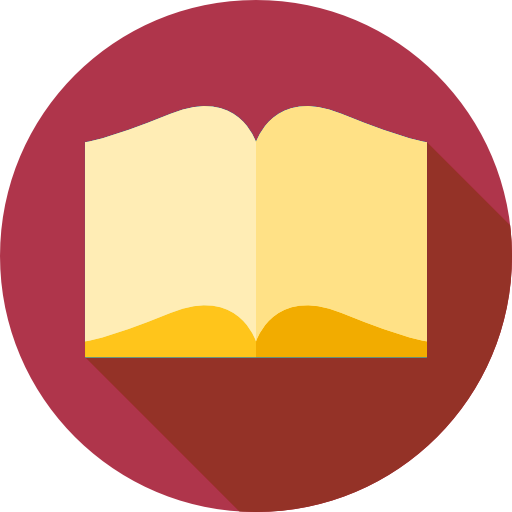
14 Comments
Jeff
If I had to do it all over again I would learn Hebrew, Aramaic and Greek and get myself a nicely bound copy of the masoretic text and textus receptus (with lots of ribbons definitely) . Oh well, so much for dreaming.
I guess I’ll just have to make do with my John Macarthur ESV study bible (not to shabby in my opinion)
Thanks for the read Scott
Leonard Williams
Very interesting. I might pick:
NKJV for translation.
Expositor’s Bible Commentary (EBC)
Notes/Maps/Charts, etc.
Black leather, lays flat
Ribbons! Lol
Word of Jesus in Red
Large print
Concordance and glossary
Mike Gifford
Take metal leader wire and add more ribbons
Scott Roberts Author
I’ve purchased Bible ribbon inserts, where five or more ribbons are held together by a piece of leather or cardboard, which you can stuff into the spine (if it’s open). I just wish they were “built-in.” 😉
Kathleen
I use plastic mesh canvas sheets. I cut them to size, then cut out several posts for slits that the ribbon can slide through. I make 3 slits down, weave the ribbon down all 3 and back up through one slit for stability. I have 6 ribbons in several of my bibles using this method. You can group them by two’s or stagger them depending on the width of the Bible. The plastic canvas is safe for my leather bound bibles and can be inserted and removed without damage to most Smythe sewn bibles.
Meagan
IS there a company that allows one to build their preferred Bible? I keep having to compromise bc I can’t find exactly what I’m looking for. NASB one column with wide margins for journaling/notes, reference Bible with a concordance and maps, and words of Christ in red. I’ve been looking everywhere and have had to compromise on several preferences. Where can I find this Bible??
Scott Roberts Author
Unfortunately, there are no real “build your own Bible” services. The closest thing you can get is a rebind on existing Bible pages. Rebinds can add some nice “outside” features, like beautiful leather covers. Because certain publishers own the licensing for some translations of the Bible, like Holman, Crossway, Zondervan, etc., and they determine what is printed for them.
Megan, your best bet is to do a Google search for the options you want.
Jen
I would love an
ESV, single column, interleaved, red letter
Cindy Meurer-Kukic
Me too, Jen! And I have a few extra requests: large font (10-11) with a nice typeface style, extra pages in the back for notes, heavier, creamy ivory opaque paper with wording broken down by verse rather than paragraph and including subject headings. And wide margins for notes, with an extra blank page at the end of each book for add’l notetaking! All of this in a volume that can lay flat and be easily carried. Is that too much to ask for?
Suzy
NIV, spiral bound, single-column text on right page and notes, charts, maps, etc. on left page. Wide margin. Simple contextual and original language study notes. No themes, no articles. Red letter is optional. No tabs. Larger print, because I’m not as young as I used to be. Yes to intro pages. No to subject headings.
If someone offered this service, they could make a fortune!
Tony Spica
I want to make a Bible in PDF because it has better “paper” and I can use my own choice of font for reading. (I’m very fond of the font Outfit.) I think the Bible has a better “read” without verse numbers. Potholes in the road.
Curt christensen
What I want is a parallel Bible with the amplified Bible, and three study bibles; NIV, CSB, and NLT life application. If these four were combined in one parallel Bible, that would be perfect.
Ten point font size, hardcover, black, with all map between the testaments.
How much would it cost for one copy of this dream bible?
heiko
I would love to build my own bible selecting the books I want to have in it (like Jubilees) and the books I don’t want in it (like Esther). At the moment I can’t find any company catering to this need so I will have to use a word-processor.
Karen Ingram
I am actually searching for this, too! Why hasn’t someone seen/filled the need? Is it really too expensive to BYOB? I would love to have:
KJV
Journaling Bible Pages
Interleaved Thick-ish Pages (Every Other Page is Blank for Notes)
Red Letter Edition
Lots of Purple-Hued Ribbons Galore
Maps and Charts Like Cray-Cray
#DreamItBuildIt